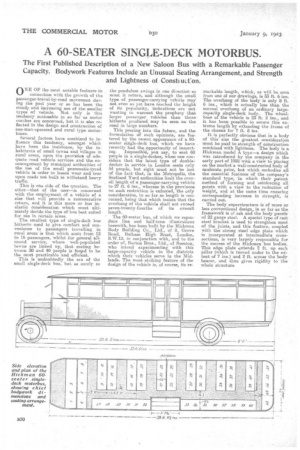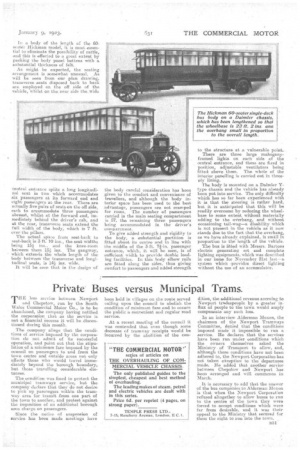A 60-SEATER SINGLE-DECK MOTORBUS.
Page 16

Page 17

If you've noticed an error in this article please click here to report it so we can fix it.
The First Published Description of a New Saloon Bus with a Remarkable Passenger Capacity. Bodywork Features Include an Unusual Seating Arrangement, and Strength and Lightness of Consti uct:on.
ONE OF the most notable features in connection with the growth of the passenger-travel-by-road movement during the past year or so has been the steady and increasing use of the smaller types of vehicle. Not only is this tendency notioeable in so far as motor coaches are concerned, but it is also reflected in the design and construction of one-man-operated and rural type motorbuses.
Several factors have combined -to influence this tendency, amongst which have been the insistence, by the inhabitants of small towns and villages in rural areas, upon the provision of adequate road vehicle services and the encouragement by municipal authorities of the use of the small pneumatic-tyrecl vehicle in order to lessen wear and tear upon roads not built to withstand heavy traffic.
This is one side of the question. The other—that of the user—is concerned with the employment of a vehicle of a size that will provide a remunerative return, and it is this more or less inelastic consideration whieli must ultimately decide the type of bus best suited for use in. certain areas.
The smallest type of single-deck bus hitherto used to give comfort and convenience to passengers travelling in rural areas is that which seats from 12 to 16 passengers, whilst for general allround service where well-pcipulated towns are linked up, that seating between 30 and 40 people is foupd to he the most practicable and efficient.
This is undoubtedly the era of the small single-deck bus, but as surely as
the pendulum swings in one direction so must it return, and although the small type of passenger-carrying vehicle maY not even as yet have reached the height of its popularity, indications are not wanting to warrant the prophecy that larger passenger vehicles than those hitherto produced may be seen on the road in large numbers.
This peering into the future, and the formulation of such opinions, are fostered by the recent appearance of a 60seater single-deck bus, which we have recently had the.oppcsitunity of inspect
ing. Impossible, you say, to seat 60 people in a single,decker, when one considers that the latest type of doubledecker in service in London seats only 54 people, but sight must not be lost of the factthat, in the Metropolis, the Scotland Yard authorities limit the overall length of a passenger-carrying vehicle to 27 ft. 6 ins., whereas in the provinces no such restriction is enforced, the only consideration, in so far as length is unlearned, being that which insists that the overhang of the vehicle shall not exceed seven-twenty-fourths of its overall length.
The 60-seater bus, of which we reproduce line and half-tone illustrations herewith, has been built by the Hickman Body Building Co., Ltd., of 8, Grove Road, Balham High Road, London, S.W.12, in conjunction with, and to the order of, Barton Bros., Ltd., of Beeston, who intend experimenting with this large-capacity vehicle in the districts which their vehicles serve in the Midlands. The most striking feature of the design of the vehicle is, of course, its re. markable length, which, as will be seen from one of our drawings, is 33 ft. 6 ins. The overhang of the body is only 8 ft. 6 ins., which is actually less than the normal overhang of an ordinary large. capacitysingle-deck body. The wheelbase of the vehicle is 23 ft. 2 ins., and it has been possible to secure this extreme length by extending the frame of the chassis for 7 ft. 8 ins.
It is perfectly obvious that in a body of this size the greatest consideration -must be paid to strength of construction combined with lightness. The body is a. Hickman model A. type—a, design which was introduced by the company in the early part of 1922 with .a view to plae..ing on the market a well-constructed body of moderate price; but which -embodies all the essential features of the company's standard type, in which their patent method of forming and reinforcing all points with a view to the reduction of weight, and at the same time ensuring corresponding increase in strength, is carried out.
The body superstructure is of more or less conventional design, in so far as the framework is of ash and the body panels of 22 gauge steel. A special type of east steel bracket is used to strengthen most of the joints, and this feature, coupled with the strong steel edge plate which is incorporated at intermediate crosssections, is very largely responsible for the Success of the Hickman bus boclieg. This edge plate extends 2 ft. up each pillar (which is turned under to the extent of 7 ins.) and 2 ft, across the body bearer, and thus gives rigidity to the whole structure.
In Li, body of the length of the 60sector Hickman model, it is most essential to eliminate the possibility of rattle, and this is effected to a great extent by packing the body panel battens with a substantial thickness of felt.
As might be expected, the seating arrangement is somewhat unusual. As will be seen from our plan drawing, transverse seats disposed back to back are employed on the off side of the vehicle, whilst on the near side the, wide
central entrance splits a long longitudinal seat in two which accommodates six passengers at its forward end and eight, passengers at the rear. There are actually five pairs of seats on the off side, each to accommodate three passengers abreast, whilst at the forward end, immediately behind the driver's cab, and at the rear, transverse seats extend the full width of the body, which is 7 ft. over the pillars.
The actual space from seat-back to seat-back is 3 ft. 10 ins., the seat widths being 15:1 ins., and the knee-room between them 151 ins. The gangway, which extends the whole length of the body between the iransveree and longitudinal seats, is 14t ins. wide.
It will be seen that in the design of
the body careful consideration has been given to the temfort and convenience of travellers, and although the body interior space has been used to the best advantage, passengers are not cramped for room. The number of passengers carried in the main seating. compartment is 57, the remaining three passengers being accommodated in the driver's compartment.
To give added strength and rigidity to the body, a substantial partition is fitted about its centre and in line with the middle of the 3.ft. 7i-in. passenger entrance, -which, it will be seen, is of sufficient width to provide double loading facilities. In this body elbow rails are fitted along the side, thus giving comfort to passengers and added strength
to the structure at, a vulnerable point.
There are three large mahoganyframed lights on each side of the central entrance, and these are fixed in position, adjustable ventilator's being fittea above them. The whole of the interior panelling is carried out in threenly lining.
.The body is mounted on a Daimler Ytypf; chassis and the vehicle has already been put into service. The only difficulty which has so far been experienced with it is that the steering is rather hard, but it is anticipated that this will be readily overcome by reducing the wheelbase to some extent without materially adding to the overhang, and without occasioning tail-wag—a disability which is not present in the vehicle as it now stands due to the fact that the overhang, as we have already explained, is small in proportion to tile length of the vehicle.
The bus is fitted with Messrs. Bartons electric generating set and complete lighting equipments, which was described in our issue for November 21st last—a system which provides direct lighting without the use of an accumulator.
































